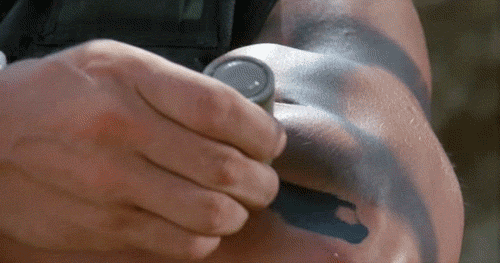Of course you don't. All you need for your workouts is yourself and a decent pair of shoes. And probably some clothes so you don't get weird stares. However, tracking your heart rate can help you measure the "oopmh" you're putting into any given workout in or outside the gym. Wearing a heart rate monitor can help you get to know yourself when it comes to movement. Seeing your own heart rate data during your workouts allows you to look at how your actual physical effort (heart rate) matches up with your mental effort (how much work you THINK you're doing). Simply put, HR monitors are a tool you can use to track progress, just like muscle mass and body fat percentages are used as tools to help monitor physical health.
Tools are meant to help you with certain tasks, and there's a time and a place to use them. An HR monitor is just one tool we can use to track our progress, and of all the tools, it's my personal favorite because it's the only one that isn't related to what we look like on the outside. It measures what's going on in your ticker and the efficiency of your cardiovascular system as a whole. Let's explore the ways that heart rate monitoring can help you get the most out of your precious time spent movin' yo bod.
1) Data.
You don't know what you don't know. Wearing a heart rate monitor gives you tangible numbers that directly correspond with what effort level it takes you to get through different workouts. In other words, how hard does your body have to work to run a mile as fast as you can? Swim 400 meters? Walk around the block? Chase your children through Target? You'll be surprised at the variability that exists between heart rate and various movement modalities.
For example, you may be able to destroy intervals during spin class while keeping your heart rate controlled - dancing beautifully between 80-85% effort during your attacks and recovering down to 70% during your active recoveries. The temperature in the room is nice and cold. You've been doing spin for a few months and have become efficient in that movement. You're burnin' it down. Feeling all confident and what-not, you decide you'll take your awesomeness outside for a run. You notice your heart rate starts to climb exponentially, even at what you consider an easy pace, and it continues to rise until you're forced to walk it out to recover. Does this mean you aren't fit? Does it mean your spin classes haven't been making your heart stronger? CALM DOWN, KAREN. NO! For starters, the temperature outside was 90 degrees. There were slight inclines/declines. And finally, because you've been using only your lower half on the bike for the last 6 months, of course it's going to be harder for you to use all of your limbs simultaneously as is required for running. That doesn't mean you aren't fit, it means you aren't as efficient in running as you are cycling. That's the beautiful frustration of fitness. We can't ever own it. We always have to work at it and rent it out - and when we stop investing in it, it kicks us out. Rude.
It's impossible to be efficient in E V E R Y type of movement all at once. Embrace it. There will always be something to fight for. So keep in mind that the style of workout, temperature, your recovery status, what you eat, hormone levels, age, gender, and a whole other host of factors determine how hard your heart will have to work during any given workout. That's why it's important that you not compare apples to bananas (HR readouts from completely different styles of workouts) in order to determine whether or not you are becoming more efficient. The goal is that over time, you become more efficient in the workout routine that you perform consistently. Try tracking your HR over time for the same workout routine for 6-8 weeks. If you discover that it is harder to reach high HR levels at the end of the trial, GOOD FOR YOU! That means your heart has become stronger. Like Arnold.

2) Awareness.
A heart rate monitor gives great insight into the condition of your cardiovascular system, especially during physical activity. It can give you great confidence knowing what your heart is doing during particular activities and how long you can sustain any given effort, especially hard efforts where sometimes we let mental barriers hold us back. Increased awareness = increased confidence in trusting yourself when it comes to knowing how fast you can drive. Tracking your HR over time can also give you great insight into what a "normal" pattern of HR data looks like for you. If you know what your normal effort patterns are for any given routine, it's much easier to identify anomalies that may otherwise go unnoticed. Knowledge is wattage!
3) Recovery.
One of the best indicators of cardiovascular health is your heart's ability to recover back down to a "close to resting" heart rate after a big push.
The time it takes your heart rate to come back down to resting after maintaining a high heart rate during a work out is referred to as a "recovery rate." The faster the recovery rate, the stronger your heart is. Remember that the heart is a muscle just like any other muscle on your body. When it pumps hard, imagine your heart muscle lifting weights. That's essentially what you're doing for your heart when you sprint, dance, HIIT, lift, row....really anything that elevates your heart rate.
Participating in activities like endurance training (zone 2/3) and HIIT training (zone 4/5) together make your heart muscle very strong. The stronger that muscle is, the faster your recovery rate will be. Here's an assessment you can perform every 6-8 to monitor changes in heart rate recovery:
1) Run, cycle, row, elliptical, or stair step at a moderate pace for 5 minutes (60-70% effort)
2) Increase effort until you reach at least 70% effort and stay there for 2 additional minutes (keep increasing effort through the 2 minutes until you get closer to 75-80% effort, but not above 80%)
3) Increase effort further until you reach 80% of your max effort and stay there for 2 more minutes (keep increasing effort through the 2 minutes until you get closer to 80-90% effort, but not above 90%). As the 2 minutes comes to an end, note your HR (HR at the end of your test)
4) Stop moving for 1 minute. At the end of the minute, note your HR (HR after 1 minute of recovery)
5) (HR at the end of the test) - (HR after 1 minute of recovery) = Your heart rate recovery!
6) Save that number and repeat the test every 6-8 weeks. If the number increases, that means your heart is getting stronger! General guidelines: an HR recovery of 30 is considered good, an HR recovery of 50-60 is considered baller. But don't get caught up in these numbers. If you do the test and your HR recovery is less than 30, don't panic. No matter where you are starting from, the most important thing is that you know your starting point and have a baseline to compare to in the future as you become stronger, because you will become stronger. Just keep moving.
4) Motivation.
Heart rate monitoring keeps your workouts spicy by encouraging you to train at a variety of different intensities, which helps you improve different aspects of heart and lung health.
Switching up your workout routine (by moving at different intensities) prevents exercise from becoming "Beullerrrr", and this can help keep you motivated long after you've achieved your initial goals. Keep making new goals!

5) Accountability.
Using a heart rate monitor is like having a personal coach. Seeing your heart rate in real time can tell you if you need to up the intensity, dial it down, or stay put. This helps to zero in on what's best for YOU so that you get the most return for the time you put into the gym. Using a heart rate monitor allows you to work and measure your efforts based on YOUR individualized settings--not your neighbor's in your workout class.
Remember, heart rate monitors are only good for you if using them makes your workouts more FUN. We are huge advocates of making workouts fun. So while this may be your first time reading about heart rate monitors or considering using one, it certainly doesn't mean that you need to rush out and buy one immediately. Take your time, ask questions, and if you need any help, we're all ears!
-Lee Ann